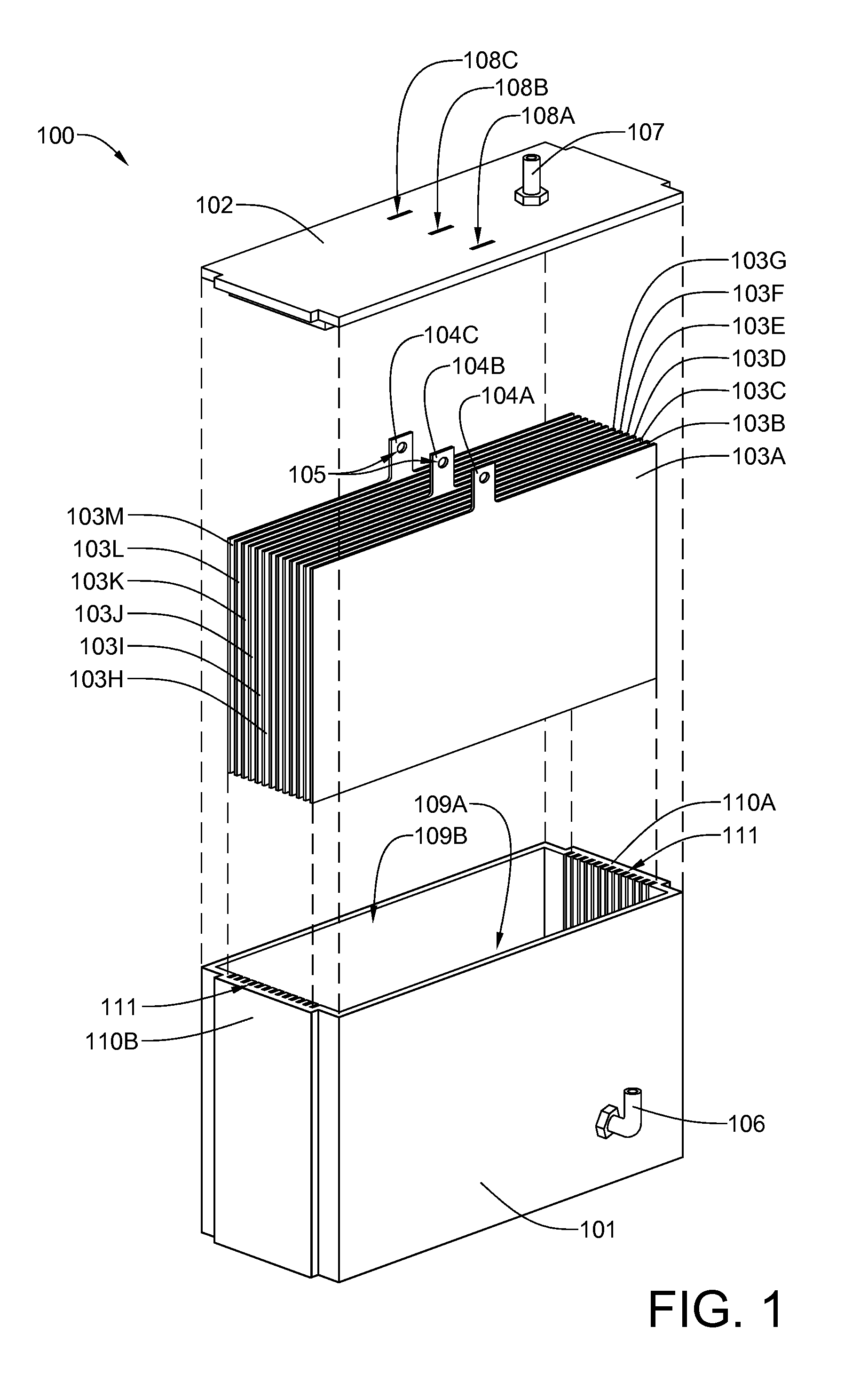Hydrogen and oxygen generator having semi-isolated series cell construction
a technology of hydrogen and oxygen generator and semi-isolated series cell, which is applied in the direction of manufacturing tools, instruments, electric circuits, etc., to achieve the effect of facilitating sealing of the upper edges, minimizing current leakage, and facilitating electrical connections the most easily mad
- Summary
- Abstract
- Description
- Claims
- Application Information
AI Technical Summary
Benefits of technology
Problems solved by technology
Method used
Image
Examples
first embodiment
[0032]Referring now to FIG. 1, an exploded first embodiment electrolysis unit 100 includes a case lower portion 101, a case lid 102, thirteen evenly-spaced, parallel laminar plates 103A-103M (103, generally). It will be noted that laminar plates 103A, 103G and 103M each have an electrical connector tab 104A, 104B and 104C, respectively, which extend from an upper central portion thereof. Each of the three connector tabs has an aperture 105 for receiving a threaded fastener that will secure an electrical cable to the connector tab. Laminar plates 103A and 103M will receive a chassis ground connection, while laminar plate 103G will receive a connection to a nominal voltage of 12 VDC. It will be noted that the case lower portion 101 is equipped with an electrolyte inlet 106. It will be further noted that the case lid has a gas outlet 107. It will be further noted that the case lid 102 has three rectangular slits 108A, 108B and 108C, which fit over the three connector tabs 104A, 104B an...
second embodiment
[0037]Referring now to FIG. 6, an assembled second embodiment electrolysis unit 600 has been assembled, with the fourteen laminar plates 403A-403N seated within their respective plate receiving slots within the case lower portion 401, the case lid 402 secured to the case lower portion 401, and the outermost laminar plates 403A and 403N seated and sealed within their respective circumferential grooves, which include their case receiving slots in the case lower portion 401 and the grooves in the case lid 402. A waterproof sealant, such as polyurethane adhesive / sealant may be used successfully to seal the case lid 402 to the case lower portion 401 and to seal the outermost laminar plates 403A and 403N within their respective perimetric grooves. As previously indicated, the partially-exposed laminar plates 403A and 403N will also be connected to chassis ground through conductors 405A and 405B, respectively. Conductor 405A is shown secured to an exposed major surface of laminar plate 403...
fourth embodiment
[0041]Referring now to FIG. 10, a fourth embodiment electrolysis unit 1000 has an ungrooved lower case portion 1001, an ungrooved lid 1002, and an ungrooved case bottom 1003. A dielectric screw 1005 passes through a central aperture of each plate 1004A-1004G. Each adjacent pair of plates has a dielectric washer sandwiched between them that is identical to the dielectric washer 1006 beneath the securing dielectric nut 1007. The dielectric screw 1005 passes through each sandwiched dielectric washer. When the screw 1005 is tightened through the plate assembly 1006, the plates 1004A-1004G assume a generally evenly spaced configuration. These plates are inserted as an assembly into an ungrooved lower case portion. However the lower and side edges of the plates are sealed to the sides and bottom of the case, respectively with a waterproof sealant, such as polyurethane sealant. The sealant is also preferably used with the embodiments having a grooved lower case portion in order to minimize...
PUM
| Property | Measurement | Unit |
|---|---|---|
| electromotive force | aaaaa | aaaaa |
| voltage | aaaaa | aaaaa |
| voltage | aaaaa | aaaaa |
Abstract
Description
Claims
Application Information
 Login to View More
Login to View More - R&D
- Intellectual Property
- Life Sciences
- Materials
- Tech Scout
- Unparalleled Data Quality
- Higher Quality Content
- 60% Fewer Hallucinations
Browse by: Latest US Patents, China's latest patents, Technical Efficacy Thesaurus, Application Domain, Technology Topic, Popular Technical Reports.
© 2025 PatSnap. All rights reserved.Legal|Privacy policy|Modern Slavery Act Transparency Statement|Sitemap|About US| Contact US: help@patsnap.com



